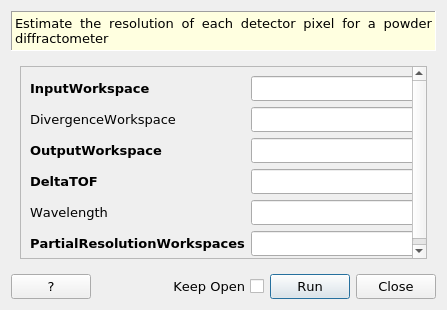\(\renewcommand\AA{\unicode{x212B}}\)
EstimateResolutionDiffraction v1¶

EstimateResolutionDiffraction dialog.¶
Summary¶
Estimate the resolution of each detector pixel for a powder diffractometer
See Also¶
This algorithm is also known as: EstimatePDDetectorResolution
Properties¶
Name |
Direction |
Type |
Default |
Description |
|---|---|---|---|---|
InputWorkspace |
Input |
Mandatory |
Name of the workspace to have detector resolution calculated |
|
DivergenceWorkspace |
Input |
Workspace containing the divergence |
||
OutputWorkspace |
Output |
Mandatory |
Name of the output workspace containing delta(d)/d of each detector/spectrum |
|
DeltaTOF |
Input |
number |
Mandatory |
DeltaT as the resolution of TOF with unit microsecond |
Wavelength |
Input |
number |
Optional |
Wavelength setting in Angstroms. This overrides what is in the dataset. |
PartialResolutionWorkspaces |
Output |
WorkspaceGroup |
Mandatory |
Workspaces created showing the various resolution terms |
Description¶
Instrument resolution¶
Resolution of a detector in d-spacing is defined as \(\frac{\Delta d}{d}\), which is constant for an individual detector.
Starting from the Bragg equation for T.O.F. diffractometer,
as
and thus
where,
\(\Delta T\) is the time resolution from moderator
\(\Delta\theta\) is the coverage of the detector, and can be approximated from the square root of the solid angle of the detector to sample
\(L\) is the flight path of the neutron from source to detector
\(\theta\) is half the Bragg angle \(2 \theta\), or half of the angle from the downstream beam
The optional DivergenceWorkspace specifies the values of
\(\Delta\theta\) to use rather than those derived from the solid
angle of the detectors. EstimateDivergence can be used for estimating the divergence.
PartialResolutionWorkspaces is a collection of partial resolution
functions where _tof is the time-of-flight term, _length is
the path length term, and _angle is the angular term. Note that
the total resolution is these terms added in quadriture.
Note that \(\frac{\Delta d}{d} = \frac{\Delta Q}{Q}\). When fitting peaks in time-of-flight the resolution is \(\frac{\Delta T}{T} = \frac{\Delta d}{d}\).
Factor Sheet¶
NOMAD¶
Detector size
vertical: 1 meter / 128 pixel
Horizontal: half inch or 1 inch
POWGEN¶
Detector size: 0.005 x 0.0543
Range of \(\Delta\theta\cot\theta\): \((0.00170783, 0.0167497)\)
Usage¶
Example - estimate PG3 partial detectors’ resolution:
# Load a Nexus file
Load(Filename="PG3_2538_2k.nxs", OutputWorkspace="PG3_2538")
# Run the algorithm to estimate detector's resolution
EstimateResolutionDiffraction(InputWorkspace="PG3_2538", DeltaTOF=40.0, OutputWorkspace="PG3_Resolution",
PartialResolutionWorkspaces="PG3_Resolution_partials")
resws = mtd["PG3_Resolution"]
print("Size of workspace 'PG3_Resolution' = {}".format(resws.getNumberHistograms()))
print("Estimated resolution of detector of spectrum 0 = {:.14f}".format(resws.readY(0)[0]))
print("Estimated resolution of detector of spectrum 100 = {:.14f}".format(resws.readY(100)[0]))
print("Estimated resolution of detector of spectrum 999 = {:.14f}".format(resws.readY(999)[0]))
Output:
Size of workspace 'PG3_Resolution' = 1000
Estimated resolution of detector of spectrum 0 = 0.00323913137315
Estimated resolution of detector of spectrum 100 = 0.00323608260137
Estimated resolution of detector of spectrum 999 = 0.00354849176520
See also
Algorithms EstimateDivergence v1.
Categories: AlgorithmIndex | Diffraction\Utility
Source¶
C++ header: EstimateResolutionDiffraction.h
C++ source: EstimateResolutionDiffraction.cpp
